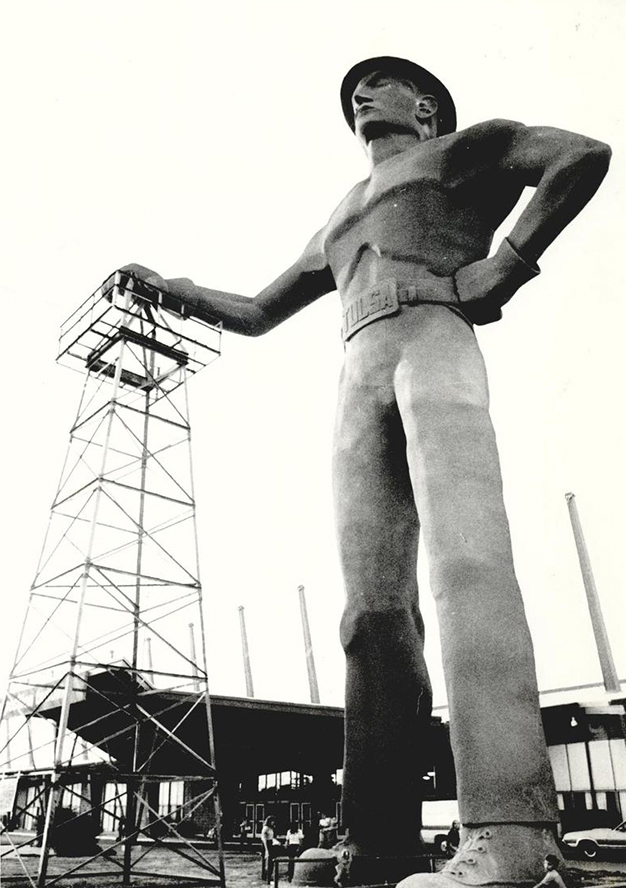The Encyclopedia of Oklahoma History and Culture
INTERNATIONAL PETROLEUM EXPOSITION.
The International Petroleum Exposition (IPE) was established in 1923 to exhibit the latest oil industry technology and provide a venue for enabling oilmen to purchase up-to-date equipment and for educating workers and the general public. Tulsa, Oklahoma, was chosen as its home, and the first show, called the "International Petroleum Exposition and Congress," was held there on October 8–14, 1923. Despite heavy rains and a martial law situation, the initial event drew enough attention to warrant being continued.
With the exception of 1926 the IPE was held annually from 1923 through 1930 for a week to ten days during October and grew in attendance from a few thousand to more than 120,000. As it was the premier show of its kind, various petroleum-related organizations, such as the Mid-Continent Oil and Gas Association and the American Petroleum Institute, scheduled their meetings in Tulsa during the exposition. Its national prominence was underscored by the variety of politicians attending the event. Attorneys general from seven states attended during 1924, and Pres. Calvin Coolidge opened the 1927 exposition from the White House by pressing a button that caused a simulated gusher to blow wild on the IPE grounds. Poor economic conditions in the 1930s caused the show to be held only in 1930, 1934, 1936, 1938, and 1940. After 1940, World War II caused activities to be suspended until 1948.
The original 1923 exposition was held near downtown Tulsa from Main to Cheyenne streets and from Archer to Cameron streets. The following year the event was moved to the old Tulsa circus grounds, remaining there until 1927. It found a permanent home on acreage leased from the Tulsa State Fair. Beginning in 1930 the date of the IPE was moved to May so that it would not conflict with the Tulsa State Fair held each fall at the fairgrounds.
In 1948, when the exposition opened for the first time since the beginning of World War II, it attracted more than three hundred thousand visitors. But due to competition from other such events, plus logistical and financial difficulties, the exposition's board of directors voted to hold it every five years in a number of buildings on twenty-plus acres at the fairgrounds. Accordingly, shows were held in 1953, 1959, 1966, 1971, 1976, and 1979. During the 1950s and 1960s the venue continued to draw in excess of three hundred thousand visitors. In 1966 all the IPE buildings were demolished and a ten-acre exhibition hall was constructed, and Mid-Continent Supply Company placed the eight-story-tall Golden Driller statue at the entrance.
In 1966 attracting the largest attendance in its history, the IPE seemed to have a secure future. Then came the 1970s oil slump. That, combined with competition from the Offshore Technology Conference in Houston, Texas, caused the event to lose money in 1976 and 1979. After a dismal attendance of twenty-six thousand people in 1979, the fifty-seven-year-old International Petroleum Exposition was canceled for all time.
See Also
Learn More
Fred S. Clinton, "The Beginning of the International Petroleum Exposition and Congress," The Chronicles of Oklahoma 26 (Winter 1948–49).
Kenny A. Franks, The Oklahoma Petroleum Industry (Norman: University of Oklahoma Press, 1980).
James P. Walker, A History of the International Petroleum Exposition and Congress, 1923–1979 (Oklahoma City: Oklahoma Heritage Association, 1984).
Citation
The following (as per The Chicago Manual of Style, 17th edition) is the preferred citation for articles:
Bobby D. Weaver, “International Petroleum Exposition,” The Encyclopedia of Oklahoma History and Culture, https://www.okhistory.org/publications/enc/entry?entry=IN030.
Published January 15, 2010
© Oklahoma Historical Society


